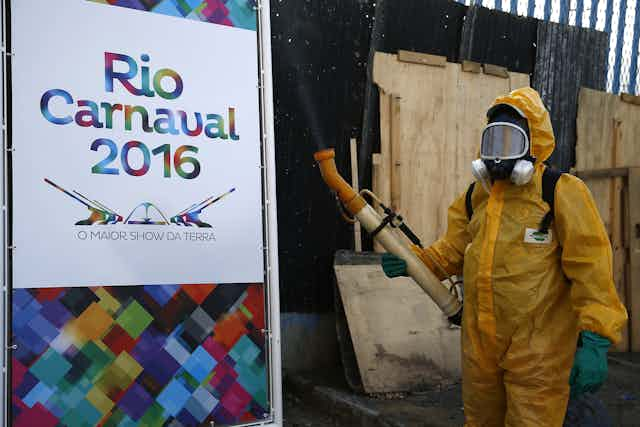It is predicted that as many as 4m people in the Americas could become infected with Zika virus this year. While the virus only causes mild symptoms in adults, it is suspected to have been behind a big increase in the number of babies born with abnormally small heads. The human cost of what is happening in Brazil is clear and undeniable. But with carnival and the Rio Olympics looming, what of the economic costs of the virus?
To get a sense of how damaging Zika will be to the prosperity of these regions, we can compare its effects with those of other recent outbreaks.
Points for comparison

One useful point of comparison is the SARS outbreak that affected Malaysia, Singapore, Hong Kong and China in 2003. In this case, the tourism industry took a hit. Measured over the year as a whole, the losses amounted to around 20% of total activity in the sector, for each of those four countries.
This impact was heavily concentrated in March and April of that year, which is when awareness of the outbreak became widespread. The impact on hotels over this period was severe; in Singapore, for example, custom was down to about a third of the normal level. By early July, the WHO declared that the outbreak had been contained, and tourism activity rapidly bounced back.
Brazil is one of the countries worst affected by the Zika virus, and tourism is an important component of Brazil’s economy. With the annual carnival coming up this month, and the country set to host the Olympic Games in August, we would expect tourism to amount to around 10% of GDP – a slight bump from its usual level of about 9%. A hit of 20% to tourism income – as happened with SARS – would be tantamount to a reduction of US$47 billion in GDP throughout the year. And of course, countries other than Brazil are affected too.
But the Zika outbreak is dissimilar to SARS in a number of respects, so we can expect its impacts to play out differently. For one thing, there is currently no vaccine for Zika, and it may take as long as a year to develop one. So the impact may be longer lasting than was the case with SARS. If the outbreak lasts a year, the adverse effect on the region’s tourism could be considerable.
There is another fact, however, which distinguishes Zika from SARS. Most infected people discern no symptoms. Since the big concern with Zika is linked to the possibility of birth defects, South America’s tourism industry could prove to be quite robust to the outbreak – with the exception of pregnant women and their families. This being the case, the negative impact on tourism may turn out to be much lower than with SARS.
Workplace disruption?
But there’s another worry: in the case of the Ebola outbreak in West Africa, the most serious costs were not down to tourism at all. The World Bank estimates that the countries worst affected by Ebola suffered a further fall of around 12% in GDP due to the direct impact of the outbreak on industrial production – a huge figure.

There were around 29,000 cases of Ebola in the West African outbreak, and around 11,000 of these were fatal. But that accounts for only around 0.15% of the population. Rather, the highly infectious nature of the disease meant that wherever cases arose, there was considerable disruption to economic activity caused by the closure of workplaces.
Zika is quite different. It is transmitted through mosquito bites and – other than through sexual contact – it cannot be transferred from human to human. So it’s highly unlikely that workplaces will need to close following any contact with the disease. As a result, the current Zika outbreak is unlikely to have a discernible effect on the output of South America’s production industries.
At this stage, it is not yet known for sure how many cases of microcephaly can be attributed to the Zika virus. But as a precaution, pregnant women in affected areas should be protected against mosquito bites and if the link is finally confirmed, this will also cut the number of cases and limit the economic costs of the virus.

